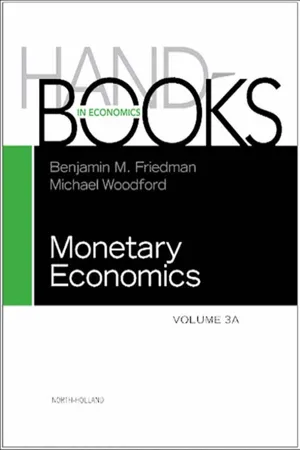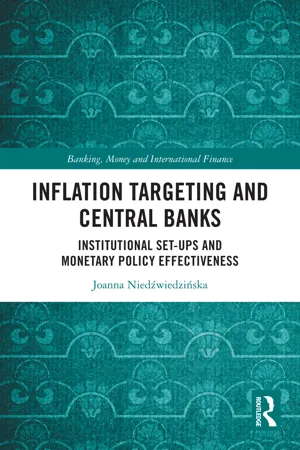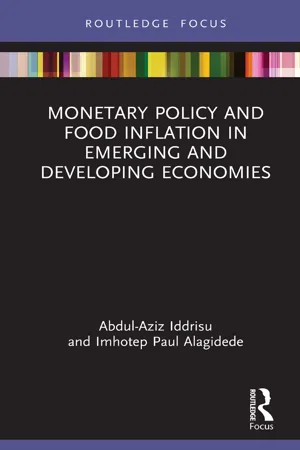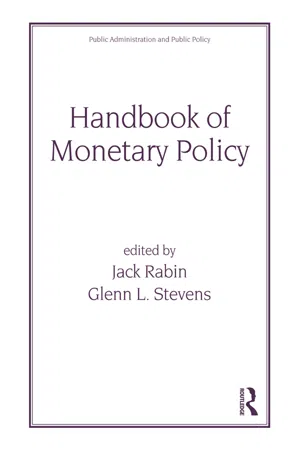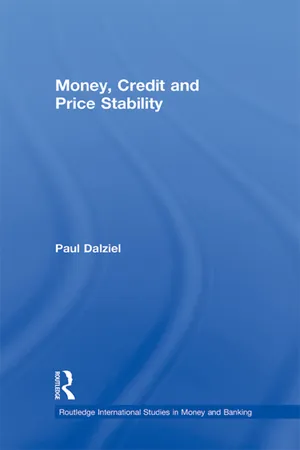Economics
Inflation Targeting in New Zealand
Inflation targeting in New Zealand refers to the monetary policy framework where the central bank sets an explicit target for the inflation rate and adjusts interest rates to achieve that target. This approach aims to maintain price stability and anchor inflation expectations. New Zealand was one of the first countries to adopt this strategy, which has since been widely adopted by other central banks around the world.
Written by Perlego with AI-assistance
Related key terms
Related key terms
1 of 4
Related key terms
1 of 3
10 Key excerpts on "Inflation Targeting in New Zealand"
- eBook - ePub
- Benjamin M. Friedman, Michael Woodford(Authors)
- 2010(Publication Date)
- North Holland(Publisher)
Monetary Economics , Vol. Suppl., No. 2011ISSN: 1573-4498doi: 10.1016/B978-0-444-53454-5.00010-4Chapter 22 Inflation Targeting*Lars E.O. Svensson, Sveriges Riksbank and Stockholm UniversityAbstract AbstractInflation targeting is a monetary-policy strategy characterized by an announced numerical inflation target, an implementation of monetary policy that gives a major role to an inflation forecast that has been called forecast targeting, and a high degree of transparency and accountability. It was introduced in New Zealand in 1990, has been very successful in terms of stabilizing both inflation and the real economy, and as of 2010 has been adopted by about 25 industrialized and emerging-market economies. This chapter discusses the history, macroeconomic effects, theory, practice, and future of inflation targeting.JEL classification E52 E58 E42 E43 E47Keywords Flexible Inflation Targeting Forecast Targeting Optimal Monetary Policy Transparency1 Introduction
Inflation targeting is a monetary-policy strategy that was introduced in New Zealand in 1990. It has been very successful, and as of 2010 had been adopted by approximately 25 industrialized and nonindustrialized countries. It is characterized by (1) an announced numerical inflation target, (2) an implementation of monetary policy that gives a major role to an inflation forecast and has been called forecast targeting, and (3) a high degree of transparency and accountability (Svensson, 2008 - eBook - ePub
- Benjamin M. Friedman, Michael Woodford(Authors)
- 2010(Publication Date)
- North Holland(Publisher)
Chapter 22Inflation Targeting
Lars E.O. Svensson Sveriges Riksbank and Stockholm UniversityAbstract
Inflation targeting is a monetary-policy strategy characterized by an announced numerical inflation target, an implementation of monetary policy that gives a major role to an inflation forecast that has been called forecast targeting, and a high degree of transparency and accountability. It was introduced in New Zealand in 1990, has been very successful in terms of stabilizing both inflation and the real economy, and as of 2010 has been adopted by about 25 industrialized and emerging–market economies. This chapter discusses the history, macroeconomic effects, theory, practice, and future of inflation targeting.JEL classification : E52, E58, E42, E43, E47Keywords Flexible Inflation Targeting Forecast Targeting Optimal Monetary Policy TransparencyContents1. Introduction12381.1 An announced numerical inflation target12391.2 Forecast targeting12391.3 A high degree of transparency and accountability12401.4 Outline12412. History and Macroeconomic Effects12422.1 History12432.2 Macroeconomic effects12442.2.11246Inflation2.2.21247Inflation expectations2.2.31248Output2.2.41249Summary of effects of inflation targeting3. Theory12503.1 A linear–quadratic model of optimal monetary policy12523.2 The projection model and the feasible set of projections - eBook - ePub
Inflation Targeting and Central Banks
Institutional Set-ups and Monetary Policy Effectiveness
- Joanna Niedźwiedzińska(Author)
- 2021(Publication Date)
- Routledge(Publisher)
Chapter 1 shows that an inflation targeting framework evolved from a pragmatic solution applied in one country in specific circumstances to combat elevated inflation, into a fully fledged monetary policy strategy that, in fact, turned out to be highly flexible. Consequently, inflation targeting has become a dominant regime among big and medium-sized countries.Inflation targeting incorporates the main conclusions drawn from monetary economics, namely, that there is no long-run trade-off between output and inflation, and that inflation is associated with costs. It also takes into account the role of expectations and the need to use a strong nominal anchor when conducting policies. Within this regime, monetary policy is thought of as a way to stabilise the economy, predominantly by maintaining price stability, but with a preference also for minimising output fluctuations. Thus, it is often stressed that central banks follow a flexible inflation targeting framework, as opposed to strict inflation targeting where monetary authorities would care only for meeting an inflation target, independently of the high costs it would cause.Looking at elements constituting an inflation targeting strategy, these include clear priority for price stability as a monetary policy objective, public announcement of an inflation target, conducting monetary policy based on a wide range of information, and fulfilling high accountability and transparency requirements, which complement the significant independence granted to monetary authorities. More generally, an IT framework is based on using certain instruments in order to meet specific targets, although it cannot be treated as a simple prescription of predetermined actions needed to reach the final objectives.It seems that the key feature that makes inflation targeting so compelling to many countries, is that, in practice, it proposes a reasonable balance between inflation and output stabilisation, without, however, sacrificing central banks’ credibility. From another perspective, it can also be seen as a compromise between a policy conducted according to rules and a policy allowing for discretion, which is possible owing to the emphasis placed on accountability and transparency within that framework. For these reasons, the notion of constrained discretion appears to be the best way to describe the essence of an IT strategy. - eBook - ePub
- International Monetary Fund(Author)
- 1998(Publication Date)
- INTERNATIONAL MONETARY FUND(Publisher)
Barro and Gordon (1983) show that adherence to a rule to determine current and future monetary policy will remove the inflation bias and result in lower inflation than under discretionary monetary policy. Inflation targeting can be seen as adherence to a rule.A third development is research arguing that accountability for the inflation outcome, supported by transparency and openness of the operating framework for monetary policy, can bring important credibility gains (Nolan and Schaling, 1996 ). Inflation targets can provide a transparent guide to the specific objectives of monetary policy, whose commitment and credibility can then be assessed on the basis of whether policy actions are taken to ensure that the targets are achieved.8 Transparency can be enhanced by the central bank publicly presenting the factors influencing the forecast of inflation, including the model upon which the forecasts are based or the judgments made by the central bank. In this way, the public can assess whether the forecasts are credible and whether any monetary policy action based on the forecasts is appropriate. Furthermore, by communicating to the public the forecast path of inflation that monetary policy seeks to accomplish, inflation targets serve as a coordination device in wage- and price-setting processes and in forming the public’s inflationary expectations. If the targets are credible, they may help anchor inflationary expectations and thereby lower the costs of achieving and maintaining low inflation.International Trend Toward Inflation Targeting
The adoption of inflation targeting in Australia followed a trend toward this approach in several advanced economies in recent years. New Zealand pioneered the approach by adopting inflation targets in 1990, and was followed by Canada (1991), the United Kingdom (1992), Sweden (1993), Finland (1993), Australia (1993), and Spain (1994) (see Table 5.1 ).Table 5.1 - Abdul-Aziz Iddrisu, Imhotep Paul Alagidede(Authors)
- 2021(Publication Date)
- Routledge(Publisher)
2 Inflation targeting framework in emerging and developing economies: Experiences and milestonesDOI: 10.4324/9781003195368-2Introduction
The inflationary episodes of the 1970s and parts of 1980s that struck a number of advanced economies prompted a transition to inflation targeting framework by these countries as monetary policy strategies such as the monetary targeting and pegged exchange rate regimes could not deliver the needed price stability (Svensson, 2011 ). Masson et al. (1997) reckon that the challenges of monetary targeting and pegged exchange rate regimes in the 1990s precipitated an exodus to inflation targeting framework by a number of advanced economies as a way to improve their inflation footprint. New Zealand was the first nation to unveil inflation targeting framework in the world in the year 1990. Other advanced countries followed, with Canada unveiling the framework in 1991, the United Kingdom in 1992, Australia in 1993 and Sweden in 1995. What the inflation targeting framework embodies and the foundations that define its successful implementation or otherwise are the subject of the succeeding sections of this chapter.The nature and pre-requisites of inflation targeting
The inflation targeting framework involves public communication of a quantitative inflation target by a central bank, to which it exercises commitment and strives to achieve in order to establish credibility and anchor inflation expectations. The framework also embodies transparency and engender accountability as monetary policy authorities regularly engage the public on decisions arrived at and the factors that informed the said decisions. Such transparency and public engagements help to shape the inflation expectations of the public in a way that engender convergence to the announced inflation target.The numerical or quantitative inflation target can be a range, a point target with or without a tolerance band (Svensson, 2011). For instance, South Africa has an inflation target range of 3%–6%; Ghana has a point target of 8% with a tolerance band of 2% (thus 8% ±- eBook - ePub
- Jack Rabin(Author)
- 2020(Publication Date)
- Routledge(Publisher)
Conducting Monetary Policy with Inflation TargetsGeorge A. KahnVice President and Economist, Federal Reserve Bank of Kansas City, Kansas City, MissouriKlara ParrishAssistant Economist, Federal Reserve Bank of Kansas City, Kansas City, MissouriReprinted from: Federal Reserve Bank of Kansas City Economic Review, v. 83, n. 3 (Third Quarter 1998) 5–32.Since the early 1990s, a number of central banks have adopted numerical inflation targets as a guide for monetary policy. The targets are intended to help central banks achieve and maintain price stability by specifying an explicit goal for monetary policy based on a given time path for a particular measure of inflation. In some cases the targets are expressed as a range for inflation over time, while in other cases they are expressed as a path for the inflation rate itself. The measure of inflation that is targeted varies but is typically a broad measure of prices, such as a consumer or retail price index.At a conceptual level, adopting inflation targets may necessitate fundamental changes in the way monetary policy responds to economic conditions. For example, inflation targeting requires a highly forward looking monetary policy. Given lags in the effects of monetary policy on inflation, central banks seeking to achieve a target for inflation need to forecast inflation and adjust policy in response to projected deviations of inflation from target. But central banks without an explicit inflation target may also be forward looking and equally focused on a long-run goal of price stability. Thus, at a practical level, adopting inflation targets may only formalize a strategy for policy that was already more or less in place. If so, targets might improve the transparency, accountability, and credibility of monetary policy but have little or no impact on the way policy instruments are adjusted to incoming information about the economy. - William Allen, David Dickinson(Authors)
- 2002(Publication Date)
- Routledge(Publisher)
1 Some Aspects of Inflation TargetingWilliam A. Allen*IntroductionThis paper discusses a number of aspects of inflation targeting in the light of the experience of the United Kingdom. It is not intended to convey any recommendations, even implicitly, about how monetary policy should be conducted in other countries, but some of the issues and topics that have arisen in the United Kingdom may also be relevant to other countries.The United Kingdom is not the only country to use inflation targeting, nor did it invent the policy. The first country to introduce it was New Zealand in 1989; other users include Canada, Australia, Israel and Sweden. The European Central Bank’s monetary policy strategy incorporates an element of inflation targeting.1The United Kingdom began inflation targeting in late 1992, and it may be useful to review some historical background. After the break-up of the Bretton Woods system in the early-1970s, the United Kingdom had a floating exchange rate and an unstable but increasing rate of inflation, which reached over 25 per cent in 1975 (Figure 1.1 ). It became clear that serious errors had been made in the conduct of monetary policy in the early-1970s, based on the mistaken belief that there was a stable trade-off between unemployment and inflation – in other words, a stable Phillips curve. It also became increasingly widely understood that the control of inflation was a necessary pre-condition for the achievement of other economic policy objectives, and therefore had to be assigned top priority among policy objectives.Figure 1.1 RPIX inflation from 1970.During the quarter-century since then, the rate of inflation has been reduced tenfold, from over 25 per cent to below 2.5 per cent. The fall in the rate of inflation has not been steady or continuous. There have been a number of crises, and a number of different monetary policy techniques have been used. Inflation targeting is the latest of them, adopted after the United Kingdom left the European Exchange Rate Mechanism, and it has been the longest-lasting. The procedures of inflation targeting are still evolving in the light of continuous learning through experience.- eBook - ePub
- Sergio Rossi(Author)
- 2007(Publication Date)
- Routledge(Publisher)
5 Monetary policy strategies
Monetary policy strategies around the world are increasingly centred on attaining some targeted rate of inflation, which several academics and policy makers assimilate to price level stability when the measured inflation rate is around but below 2 per cent (owing to a number of measurement biases, as reviewed by Rossi (2001: 31–41)). As a matter of fact, targeting inflation has become a fashion. Since the Reserve Bank of New Zealand first adopted this monetary policy strategy in 1990, an increasing number of monetary authorities around the world – first in advanced economies only, later also in developing and emerging market economies – have been abandoning their monetary or exchange rate targeting strategy to follow this new fashion. As with several fashions nevertheless, targeting an inflation rate rather than an exchange rate or a growth rate of a monetary aggregate has been adopted without any fully thought-out analytical investigation of a phenomenon as complex and controversial as inflation. The same may be argued with respect to previous monetary policy strategies, as they all stem from a symptom-based perception of inflation.It is indeed both undisputed and undisputable today that ‘[e]conomists’ perceptions of inflation rest on measurements of the “general price level” and on rates of change of price indexes’ (Gale 1981: 2). In fact, as surveys of inflation theories show, neither a satisfactory nor an exact analytical definition of inflation exists as yet in the literature (see Bronfenbrenner and Holzman 1963, Laidler and Parkin 1975, Frisch 1983, Parkin 1987, McCallum 1990). This is so much so that, to date, the phenomenon of inflation has been grasped merely by considering its most evident symptom, namely the increase of the relevant consumer price index (or some core inflation index), with no analytical thought whatsoever as to its underlying cause. - eBook - ePub
- Paul Dalziel(Author)
- 2000(Publication Date)
- Routledge(Publisher)
This agreement is renegotiated whenever the Governor is appointed or reappointed (normally for a term of five years) or by mutual agreement. It has three key components: 1 a numerical inflation target, currently defined to equal 0–3 per cent annual increase in the consumers price index; 2 a recognition that the bank is not obliged to offset the direct impact of significant supply-side shocks such as terms of trade movements, indirect tax changes and natural disasters; and 3 an explicit obligation for the bank to be fully accountable for its judgements and actions in implementing monetary policy, which are required to be sustainable, consistent and transparent. In keeping with this last requirement, the Reserve Bank publishes a Monetary Policy Statement approximately every three months, which is referred to Parliament and reviewed by the latter’s Finance and Expenditure Select Committee. This basic elements of this policy framework are now widely accepted by many central banks. 4 Where New Zealand departed from general international practice – at least until March 1999 – was its choice of policy instruments. In 1985, the Reserve Bank introduced ‘primary liquidity’ as its operating target, defined to equal the quantity of settlement cash balances held by financial institutions at the Reserve Bank plus the quantity of short-term government securities on issue that were discountable by the bank on demand. This was the closest New Zealand came to targeting a monetary aggregate, but the experiment was short-lived (although primary liquidity targets continued to be published until December 1987) - eBook - ePub
Innovation and Independence
The Reserve Bank of New Zealand
- John Singleton, Arthur Grimes, Gary Hawke, Frank Holmes(Authors)
- 2013(Publication Date)
- Auckland University Press(Publisher)
67Recovery and breaches of the target
Having attained price stability, the next challenge for the Bank was to maintain it during an economic recovery. The strength of the recovery caught most people, including the Governor, by surprise. Annual CPI inflation rose above 2 per cent at times during 1994, 1995, and 1996, but remained very low by the standards of previous decades. (Formal caveats were not invoked for these breaches of the target range.)In response to the re-emergence of inflationary pressure, the Bank began to pay more attention to a relatively neglected indicator: the interest rate. The Bank also sought improved methods of signalling its monetary policy intentions. Rising inflationary pressure led to some tightening of policy in the mid-1990s, which played a significant part in the strong appreciation of the New Zealand dollar.Looking back on the recovery, the Bank accepted that it had underestimated the strength of domestic demand and overestimated growth in the productive capacity of the economy. Furthermore, it had placed too much faith in the direct exchange rate pass-through (see above). An appreciating currency could not quell all inflationary pressures, especially those originating in non-tradeable sectors such as construction. Domestic demand was also boosted by high immigration, and by rising business and consumer confidence. Surging house prices brought the perception of increased wealth and encouraged homeowners to borrow and spend.The post-1984 reforms did not lead to a rapid overall improvement in economic performance, as some had anticipated. The New Zealand economy actually weakened in the late 1980s and early 1990s, and many became disillusioned with the reform process. Indeed, it was not until 1992–3 that a strong recovery got underway. BOB BROCKIE, ALEXANDER TURNBULL LIBRARY, H
Index pages curate the most relevant extracts from our library of academic textbooks. They’ve been created using an in-house natural language model (NLM), each adding context and meaning to key research topics.
Explore more topic indexes
Explore more topic indexes
1 of 6
Explore more topic indexes
1 of 4
